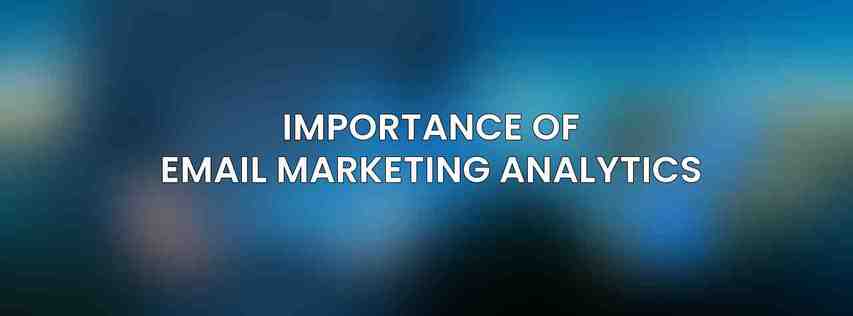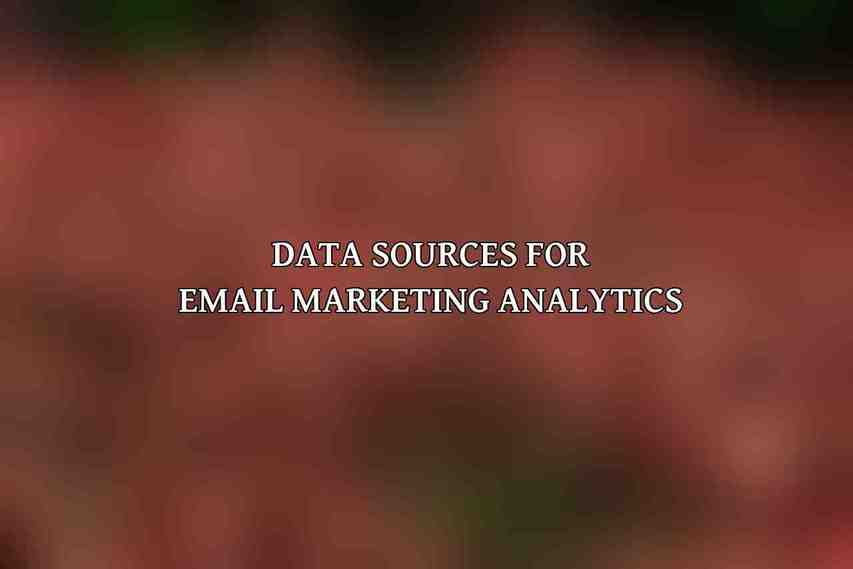Email marketing analytics refers to the process of tracking and analyzing the performance of email marketing campaigns. By measuring various metrics, businesses can gain insights into the effectiveness of their email strategies and make data-driven decisions. The data collected through email marketing analytics enables marketers to understand subscriber behavior, improve campaign performance, and ultimately drive better results.
Definition of Email Marketing Analytics
Email marketing analytics involves the measurement and analysis of key metrics related to email campaigns. It includes tracking metrics such as open rates, click-through rates, conversion rates, bounce rates, and list growth rates. Analyzing this data helps marketers assess the success of their email efforts and make informed decisions to enhance future campaigns.
Importance of Email Marketing Analytics

Measure campaign effectiveness: Email marketing analytics allows businesses to gauge how well their campaigns are performing by providing insights into subscriber engagement and conversion rates.
Identify areas for improvement: By analyzing key metrics, marketers can identify weaknesses in their campaigns and take steps to enhance content, design, or targeting strategies.
Optimize future campaigns: Through data-driven insights, businesses can refine their email marketing strategies for better results in terms of engagement, conversions, and overall campaign effectiveness.
Data Sources for Email Marketing Analytics

To gather and analyze email marketing data effectively, marketers can leverage various data sources, including email marketing software, Google Analytics, and social media analytics platforms.
Email Marketing Software
Popular email marketing platforms like Mailchimp and Constant Contact offer robust analytics tools that provide insights into campaign performance and subscriber behavior. Marketers can access detailed campaign reports and subscriber data to evaluate the success of their email initiatives.
| Data Source | Features |
|---|---|
| Campaign Reports | Metrics like open rates, click-through rates, and conversions |
| Subscriber Data | Insights into subscriber demographics, behavior, and preferences |
Google Analytics
Integrating Google Analytics with email campaigns allows marketers to track website traffic originating from email marketing efforts and measure key metrics related to goal completions, such as purchases or sign-ups.
| Data Source | Features |
|---|---|
| Website Traffic | Monitoring traffic generated from email campaigns |
| Goal Completions | Tracking actions taken by visitors from email links |
Social Media Analytics
Platforms like Facebook Insights and Twitter Analytics can provide valuable data on how email-related content is performing on social media, as well as the traffic generated from email campaigns.
| Data Source | Features |
|---|---|
| Engagement Metrics | Assessing engagement levels with email content on social media |
| Social Media Traffic | Analyzing the traffic driven to websites from email promotions |
How to Analyze Email Marketing Data
Analyzing email marketing data effectively involves setting up tracking mechanisms, reviewing campaign performance, identifying trends, and using insights to optimize future campaigns.
Set Up Email Marketing Analytics
Configure tracking mechanisms: Implement tools like UTM parameters to track campaign performance and monitor the effectiveness of email links.
Integrate software with analytics tools: Connect email marketing platforms with analytics solutions for seamless data collection and analysis.
Analyze Campaign Performance
Review key metrics: Assess metrics like open rates, click-through rates, and conversion rates to evaluate the success of email campaigns.
Segment data: Divide subscriber data into groups based on factors like location or demographics to tailor future campaigns effectively.
Identify Trends and Patterns
Monitor metrics over time: Track key metrics consistently to identify patterns, seasonality effects, and fluctuations in subscriber behavior.
Utilize correlations: Identify relationships between different metrics to understand how they impact campaign performance and subscriber engagement.
Use Data to Optimize Campaigns
Adjust content and design: Modify email content, layouts, and designs based on data insights to improve engagement and conversion rates.
Experiment with different strategies: Test variations in subject lines, send times, and targeting approaches to optimize campaign performance.
Enhance list segmentation: Refine subscriber segmentation strategies to deliver more personalized and relevant content to recipients.
Leveraging Email Marketing Analytics for Growth
Utilizing email marketing analytics effectively can empower businesses to personalize their campaigns, enhance customer engagement, and increase conversions.
Personalize Email Marketing
Tailor content and offers: Use subscriber data to create personalized email content and offers that align with recipient preferences and behavior.
Implement automated sequences: Develop automated email sequences triggered by subscriber actions to deliver timely and relevant messages.
Improve Customer Engagement
Segment subscribers: Group subscribers with similar interests or behaviors to send targeted emails that resonate with their preferences.
Provide value: Deliver content that adds value to subscribers’ lives, nurtures relationships, and encourages ongoing engagement.
Increase Conversions
Analyze conversion-driving emails: Identify emails that lead to the most conversions and optimize content and design elements to replicate success.
Enhance conversion rates: Experiment with different strategies, CTAs, and design elements to improve conversion rates and drive more actions from recipients.
email marketing analytics plays a vital role in shaping successful email campaigns by providing valuable insights and data-driven strategies. By measuring key metrics, analyzing performance, and leveraging data to optimize campaigns, businesses can enhance their email marketing efforts and drive better results. Remember, the key takeaways from this guide are to always measure and analyze key metrics, use data to optimize campaigns, and leverage insights to fuel email marketing growth. By continuously refining strategies based on data-driven decisions, marketers can maximize the impact of their email marketing initiatives and achieve substantial growth in engagement and conversions.
Frequently Asked Questions
What is email marketing analytics?
Email marketing analytics is the collection and analysis of data related to email marketing campaigns and strategies. It involves tracking various metrics such as open rates, click-through rates, conversion rates, and overall campaign performance.
What are the key metrics to track in email marketing analytics?
Some key metrics to track in email marketing analytics include open rate (percentage of recipients who open the email), click-through rate (percentage of recipients who click on a link within the email), conversion rate (percentage of recipients who complete a desired action after clicking on a link), bounce rate (percentage of emails that were not delivered successfully), and unsubscribe rate (percentage of recipients who opt out of receiving further emails).
How can email marketing analytics benefit beginners?
Email marketing analytics can benefit beginners by providing valuable insights into the performance of their email campaigns. By tracking key metrics, beginners can understand what is working well and what can be improved in their email marketing strategies. This data-driven approach can help improve campaign effectiveness and drive better results.
What tools are available for beginners to measure email marketing analytics?
There are various tools available for beginners to measure email marketing analytics, such as Google Analytics, MailChimp, Constant Contact, and HubSpot. These tools offer features for tracking and analyzing key metrics, creating reports, and optimizing email marketing campaigns for better results.
How can beginners use email marketing analytics to improve their campaigns?
Beginners can use email marketing analytics to improve their campaigns by analyzing the data to identify trends, patterns, and areas for optimization. By monitoring key metrics, beginners can make data-driven decisions on content, design, timing, and targeting to improve the overall performance of their email marketing campaigns.
